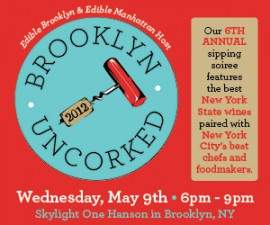7 Things You Need to Know About Regional Wine (Jeff Siegel, Wine Curmudgeon)
Editor's Note: It's Regional Wine Week and while it's difficult to make this website any more locally focused, I wanted to draw some attention to the effort. As a member of the Drink Local Wine board of directors, I wanted to re-publish this post by DLW president, Jeff Siegel. I think it captures the essence of what DLW is all about.
By Jeff Siegel, The Wine Curmudgeon
This is DrinkLocalWine's fourth annual regional wine week, which means all sorts of goodies and festivities at DrinkLocalWine.com, including the 47-word essay contest and voluminous links to regional wine stories, photos and interviews. The blog will be all regional wine this week; but don't worry, it won't hurt.
That's because, to paraphrase my partner in the locapour movement, Dave McIntyre, local wine is no longer a novelty. There are thousands of regional wineries, they're in each of the 47 states that aren't California, Washington, and Oregon, and the quality of the wine has improved dramatically in the past decade. But that doesn't mean that regional is as respected as it could be, or that nearly enough people know about it. So, after the jump, seven things you need to know about regional wine:
- You have to taste the wine before you can decide if it's any good. Yes, this is bothersome to so many in the Winestream Media who just know — because they are smarter than the rest of us — that regional wine sucks. Or blows. Or hurls. Or is lame. So they don't have to taste it. Also, you can't criticize regional wine if you haven't tasted it in the past 10 years. That one trip to that one winery where they had that awful chardonnay and you know that all regional wine tastes exactly like that because it did then? Can't use that excuse any more.
- California has not always been the center of the wine universe. The U.S. wine industry was in the Ohio River valley during the Civil War, and Missouri at the end of the 19th and beginning of the 20th centuries. California didn’t become the predominant wine state until after World War II — and it suffered in the shadow of France until the late 1970s. Those were the days of mountain chablis, often made with table grapes, and hearty burgundy, a red blend that had nothing to do with pinot noir. If you had asked a serious wine drinker what they thought of California wine four decades ago, they might have sounded an awful lot like someone describing regional wine today. (Though they probably would have used the adjective "gross" instead of "lame.")
- Regional wine is not supposed to taste like California wine. Or French wine. Or like any wine other than where it is from. Missouri wine tastes like Missouri wine, and there's nothing wrong with that. One of the ironies about the wine business that drives me crazy is that the Winestream Media fell all over itself embracing Australia's unique style, yet doesn't seem the least bit interested in granting that privilege to any other new region.
- Yes, regional wineries make sweet wine. So does California. And your point is?
- The number of regional wineries in the U.S. increased 44 percent between 2005 and 2010, from 1,550 to 2,765, according to the Wine America trade group. Which means there are a lot of wineries in lots of places that you wouldn't think. The top seven regional wine states by number of wineries in 2010 (also from Wine America): New York (303); Texas (219); Virginia (210); Michigan (159); Pennsylvania (159); Ohio (149); and Missouri (112).
- It's OK for regional wineries to make wine from grapes that aren't chardonnay, merlot, cabernet sauvingon and pinot noir. In fact, one of the things that held regional wine back over the last decade is that its producers were caught between a rock and a hard place. California had done such a good job educating consumers about these traditional varietals that regional producers had to make them because they could sell them — even when their terroir wasn't exactly suited to them. That was the case in Texas for years, when growers struggled with the classic grapes despite a climate that was too hot and too dry. Hence Texas had a lot of chardonnay that gagged.
- Yes, regional wine can be overpriced. But so can California wine, French wine, Italian wine, Spanish wine, Australian wine and just about any wine that you can think of. That's an excuse not to try regional wine, not a reason. Besides — and given my devotion to cheap wine, I would not say this if it wasn't true — there is good cheap regional wine. It's more difficult to find, and there is less of it, but it's there.















Hey Lenn,
That was an interesting guest post by Mr. Siegel. I can’t say I agree with most of the points made here, but I’m only a blobber [oh I mean blogger].
But I have to say I’m in 100% agreement with the first point made. Tasting the wine before passing judgment is at least good form. But sometimes living by the courage of my convictions can be rather painful in that regard.
I’ve tasted through many “local” samples more than once [talking San Diego]. Those wines made with-in the boundaries of San Diego, I’m sorry to say far too many represent an experience I don’t want to repeat. The wines that do stand-out typically are produced from grapes not grown in San Diego.
I understand the whole “drink-local” movement but even you must admit there are many [NOT ALL] of the other states [outside of NY, VA, CA, WA, OR] who produce wines that beg the question, “why” as in why did you bottle that? With that said, I still explore new wines when I’m presented with the opportunity.
Cheers,
Bill